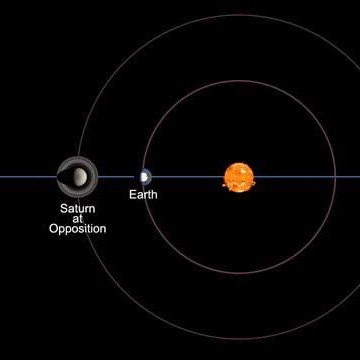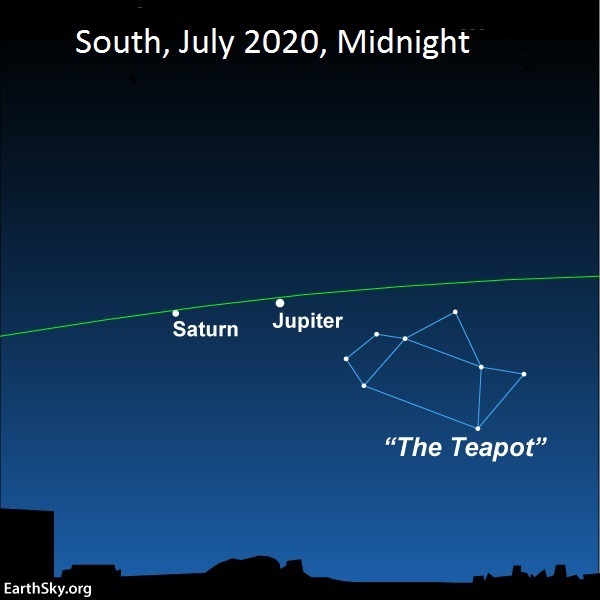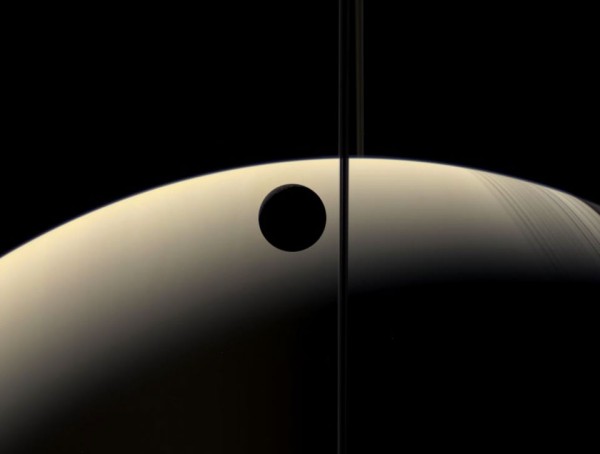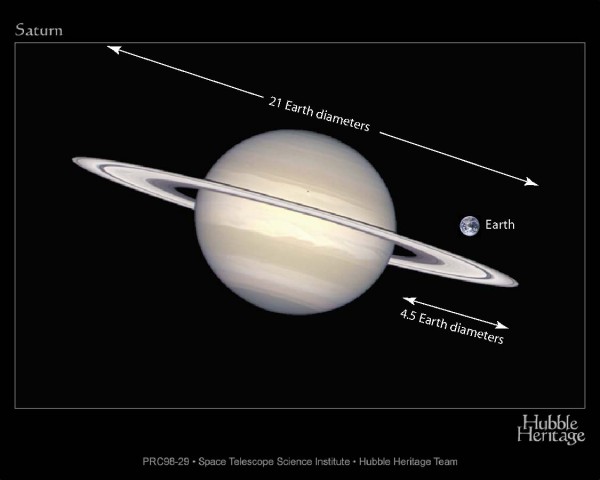
Illustration above via NASA; not to scale.
Our planet Earth flies between Saturn and the sun on July 20, 2020, bringing Saturn to what astronomers call opposition to the sun in our sky. Opposition is a big milestone each year for observing the ringed planet Saturn, or any outer planet. When we fly between that planet and the sun, the planet is generally closest to Earth and brightest for that year. Saturn’s opposition comes on July 20 at 22 hours UTC.
That is 7 p.m. ADT, 6 p.m. EDT, 5 p.m CDT, 4 p.m. MDT, 3 p.m. PDT, 2 p.m. Alaskan Time and 12 noon Hawaiian Time; click here to translate UTC to your time.
And don’t worry about exact times too much. Just know that – around now – Saturn is more or less opposite the sun in Earth’s sky, rising in the east around sunset, climbing highest up for the night around midnight and setting in the west around sunrise.
When opposite the sun, Saturn is visible all night and at its brightest seen from Earth. What’s more, the moon turns new on Saturn’s opposition date (July 20, 2020), guaranteeing moon-free skies on Saturn’s special day.
Viewing Saturn’s rings soon? Read me 1st

Jupiter reaches opposition on July 14, 2020, and about a week later, Saturn sweeps to opposition on July 20, 2020. Look first for dazzling Jupiter, and that nearby golden “star” a short hop to the east of Jupiter is actually Saturn. In July 2020, these two worlds climb highest up for the night around midnight (middle of the night). A month from now, the dynamic twosome will be highest up for the night around mid-evening.
The ringed planet will be in good view in the evening sky for the rest of July and throughout August, September and October 2020. You can recognize Saturn because it’s near another planet, Jupiter. Jupiter is an exceedingly bright light in our sky, brighter than any star. Saturn is the bright golden “star” a short hop to the east of Jupiter.
Saturn and Jupiter will stay close together on the sky’s dome throughout 2020. They’ll remain fixtures of the evening sky for the rest of this year. All the while, golden Saturn and dazzling Jupiter will shine, as they do now, in front of the constellation Sagittarius. You’ll know this constellation for its recognizable Teapot asterism, shown on the chart above.
Read more: Before 2020 ends, a great conjunction of Jupiter and Saturn
Although Saturn comes closest to Earth for the year about 5 hours after it reaches opposition, the ringed planet comes nowhere as close to Earth as the NASA illustration at the very top of this post might lead you to believe. At present, Saturn lies some 10 times the Earth’s distance from the sun, and 9 times the Earth-sun distance from Earth. Astronomers refer to one Earth-sun distance as an astronomical unit, or AU. Saturn is now 10 AU from the sun, and 9 AU from us. Heavens Above gives information about the present distances of the planets from the sun and Earth.
So the distance scale of the image at top is off, and so is the size scale. For a realistic depiction of Saturn’s size relative to that of Earth, see the illustration below.
Our fast movement in orbit brings Earth between Saturn and the sun every year – or, more precisely, about two weeks later every year. Five years ago, for instance, Saturn’s opposition happened on May 23, 2015. In 2016, it was June 3. In 2017, it was June 15. In 2018, June 27, and in 2019, it was July 9. If you recognize this golden world tonight or later this month, you’ll also enjoy it throughout the Northern Hemisphere summer, or Southern Hemisphere winter.
If you had a bird’s-eye view of the solar system today, you’d see our planet Earth passing in between the sun and Saturn. You’d see the sun, Earth, and Saturn lining up in space. But not for long. Earth moves in orbit at 18 miles (29 km) per second in contrast to about 6 miles (9 km) per second for Saturn. Soon, we’ll be pulling ahead of Saturn in the race of the planets.
The planets that orbit the sun inside of Earth’s orbit – Mercury and Venus – can never be at opposition. Only the planets that orbit the sun beyond Earth’s orbit – Mars, Jupiter, Saturn, Uranus, Neptune, and the dwarf planet Pluto – can ever reach opposition, that is, appear opposite the sun in Earth’s sky.
All the planets farther from the sun reach opposition every time our swifter-moving planet sweeps between the sun and these superior planets – planets that orbit the sun outside of Earth’s orbit. Mars returns to opposition every other year. Jupiter’s opposition happens about one month later each year, whereas Saturn’s opposition occurs about two weeks later yearly. The farther that a planet resides from the sun, the shorter the period of time between successive oppositions.
Saturn, the sixth planet outward from the sun, is the most distant world that’s easily visible to the unaided eye. Telescopes revealed its rings in the 17th century. Spacecraft in the 20th century revealed that what we thought of as three rings around Saturn to be thousands of thin, finely detailed rings – made of tiny chunks of ice. Saturn also has 62 moons with confirmed orbits. Only 53 of Saturn’s moons have names, and only 13 have diameters larger than 50 kilometers (about 30 miles).
Saturn is truly a wondrous world of rings and moons. It’s everyone’s favorite celestial object to gaze at through a small telescope, so if there’s a public astronomy night near you this month – go!
Enjoying EarthSky so far? Sign up for our free daily newsletter today!

The Cassini spacecraft, which orbited Saturn from 2004 to 2017, obtained almost unbelievably stunning images of the planet. Here, a moon, Rhea, occults – or passes in front of – a crescent Saturn. Image via Cassini Imaging Team, SSI, JPL, ESA, NASA. See more images of Saturn from Cassini.
Bottom line: Look for Saturn at and around opposition – July 20, 2020. It will be shining in the southeast at nightfall. Clouded out tonight? No problem. Saturn will be in an excellent place to observe throughout July, August and September 2020.
Source:
https://earthsky.org/tonight/saturn-closest-and-brightest
